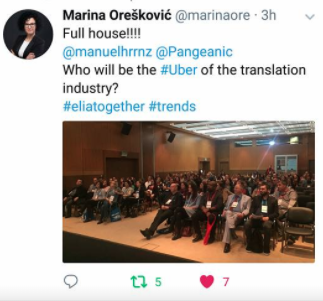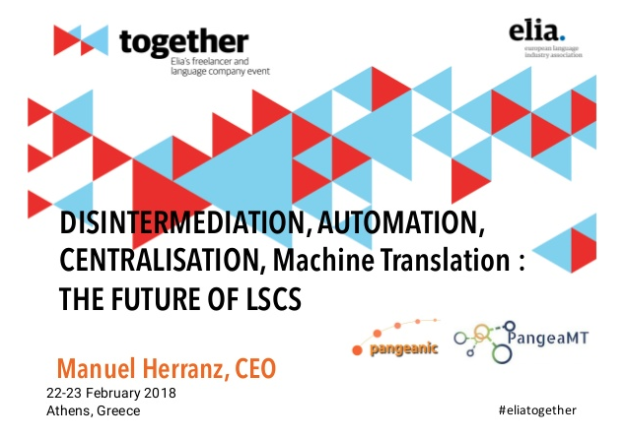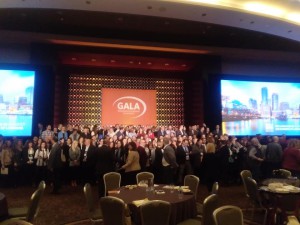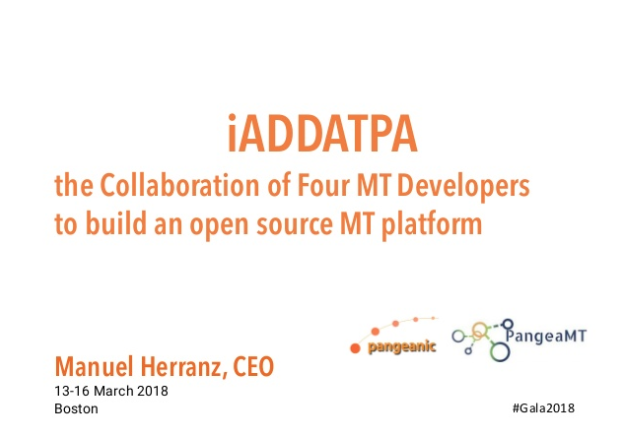Speaking at two conferences in two very different scenarios and to two very different audiences gives you the precious opportunity to get a taste of what the market thinks, the fears and the wishes. By market I mean people that represent business, companies or represent themselves but they have an influence on what others think in their profession. In my case, this is happened in Athens at the Elia Together conference and at Gala Boston recently.
Although the presentations were targeted at two very different groups, they shared some common ground. Both audiences contained professional translators and linguists and representatives of translation companies.
The presentation in Athens dealt more with the future of translation as a profession, some marketing development tips and a short summary of our iADAATPA open source multi-MT platform project which inevitably led to the question of "How does neural machine translation work"?.
The presentation in Boston was solely dedicated at the iADAATPA platform and how it will become an open source MT platform with ready-tested plugins and APIs to CAT tools and MT services, with a little overlap on how does neural machine translation work. Let me share with you a few things I learnt from talking to professional translators and translation business over the last two months.
Elia Together Athens
The Uber of translation
Full house. More than 100 people sat to take away some lessons about how the business model for medium and small translation agencies must change (well, even for the model of the large ones) and embrace B2C. It's not that the typical cascade buying and selling will disappear, but many companies and even freelancers have not realized yet how many times people use Google nowadays to search for services... including translation services. And it doesn't matter if you are in Boston, Athens, Osaka, Guadalajara City or Lyon. Well-delivered services can be anywhere as long as they can deliver what they promise. Look at Amazon. I hammered home the idea that few translation companies actually do what they say they do (translate, for example their own website in 10 languages). They don't speed and solve communication problems (they actually create a layer of administrative work).

The point about disintermediation seemed to be interesting more for companies than for freelancers. As large text loads head towards higher quality neural machine translation (which begins to be almost indistinguishable from humans), the idea of microservices and hourly rates begins to settle in the minds of translation managers and translators alike. A mixed audience as it was (half freelancers, half companies), I was surprised to see the interest in iADAATPA open source multi-MT platform that will not only provide free machine translation to public administrations via eTranslation from the European Commission, but will also be free to for use as an multi-MT vendor platform by private individual and industry. Having a single hub where all your connectors and APIs are already in place so you can use best performing engines in domains and language pairs from several MT vendors is attractive not only for the European Union. It is attractive to anybody that would like an on-premise machine translation platform.
In 2006, Google ditched a ruled-based system (Systran) to develop its own platform. In 2010 the first statistical machine translation with re-training features was released as PangeaMT. Many followed, mostly as SaaS and cloud services. But no full MT management platform has ever become open source. APIs and connectors have remained fiercely proprietary. iADAATPA will make MT much easier to run and change from one provider to another, even at company level. A version of my presentation can be seen in slideshare.

Gala Boston 2018
The Language of Business. The Business of Language
Language conferences are a thing to see. They really are different to most types of conferences: the interaction, the almost incestuous in-selling... you don't see rookies, middle management or small practices in tool machine exhibitions, life sciences conferences, not even in toy and fair exhibitions. At language conferences you can speak to a tool developer who doubles up in the executive board, representatives of think tanks and partners in a small business.
My talk this time was for a smaller audience and more focused on iADDATPA as an EU project (part of the Connecting Europe Facility initiative). I had kept some common slides from Greece to briefly explain how neural machine translation works but I didn't get there practically. I invited the audience to ask any time as I introduced the platform and a very inquisitive audience did just that. So no more than 7 minutes into the presentation, the audience was asking the right questions: "When will be able to get our hands on it?" "Is this the beginning of a dynamic benchmark?" "A real marketplace of machine translation where the system decides the best system producing a paragraph, or a sentence?" "How will you decide intelligently one system is better than the other?" "What happens if you re-train?" "Will it be able to re-train own engines?" "Can iADAATPA be deployed on-premise?".
All I could think is that audiences, or the market, is very eager not just to adopt the technology in passive mode, but to own it, play with it, customize it and be able to run its own machine translation hub for its clients. Linking up to the ELIA presentation in Athens, I sense the savvy business have already realized that there is a huge change in the business model in the pipeline and that MT is not the realm of the top ten companies in the world or large multinational organizations. It's likely to become the CAT tool and the service everyone provides in the near future. I couldn't attend all talks, but I'd like to summarize a very worthy initiative: TAPICC, from Gala itself.
Currently API landscape is a wild west with a lot of unnecessary variation and a continuous reinvention of the wheel, with a lot of wasted money for clients, LSPs and tool vendors, leading to a loss of operational freedom. The aim of TAPICC is to unify the API scenario, working with industry, academics, in a similar vein as iADAATPA is doing by bringing together several machine translation players offering a single access point and common APIs to connect to many CAT tools and MT deployment scenarios.

TAPICC has created several working groups and agreed upon uses and a useful framework for metadata, use cases, best practices, and classes, so it is now looking for quickly implementable classes and use cases and iADAATPA can well be one of them by deploying its standard as a single access point for machine translation services. Thus, it will reduce the cost of integration and will allow for quickly onboard new clients and systems, LSPs, etc., finally easily embedding L10N in content processes and enterprises. A 2nd objective of TAPICC is the interaction between different systems so that 2 TMs tools can talk to each other.
This is happening already on a proprietary level and they are all different and TAPICC wants to support everything. A good use scenario, for example, can be the semantic enrichment of units, terminology, TM and MT for example in an xliff file that asks for terminology results and with a layout that is "good enough". In one word, it can be as simple as having a file that needs to be sent to a machine translation engine but keeping the same format. As TAPICC is already looking for use cases, the API specification can start to be tested and shaped during development stage. A version of this presentation can also be seen in slideshare.



